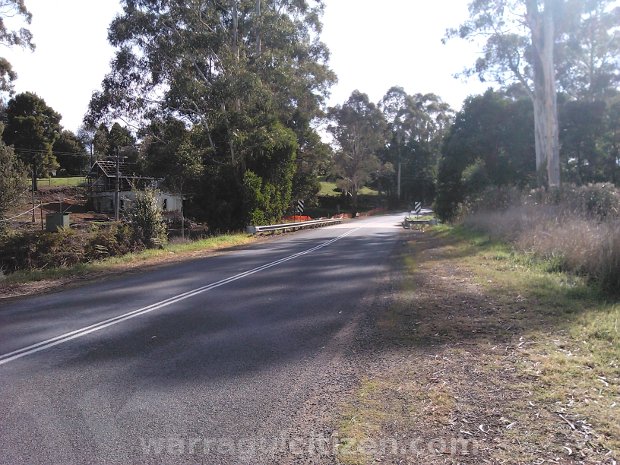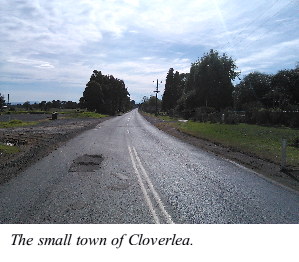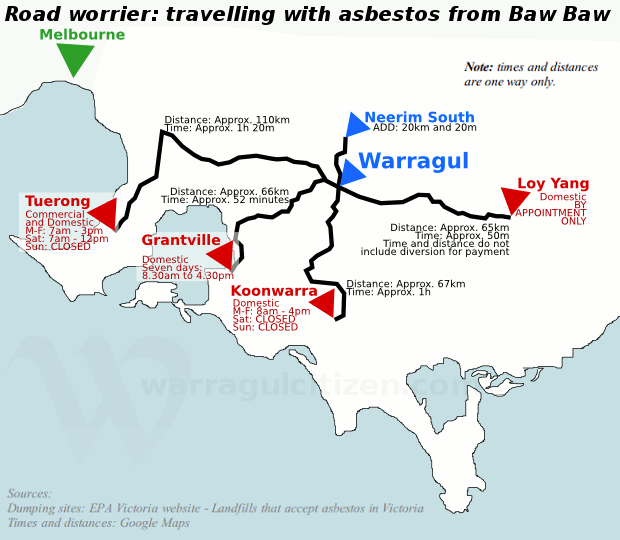
Baw Baw is known for its natural beauty and the small towns along the Princes Freeway claim some of the more beautiful countryside Gippsland has to offer.
Pictured: Darnum-Allambee Road at its intersection with the Little Moe River. Please note the building in shot is not related to the story. All images and illustrations by William PJ Kulich.
ADVERTISEMENT
Darnum-Allambee Road is a prime example. The small but surprisingly busy road rolls past the Darnum Musical Village tourist spot, through farmland to the small town of Cloverlea and beyond.
But something potentially deadly lurks by the side of the road; something placed there not by nature, but by people trying to save time and money. And it could easily end up on a road near you.
Illegal and unsafe dumping of asbestos is an issue in regional areas like Baw Baw. Distance to an appropriate disposal site and the cost of disposal can be prohibitive and there is an apparent confusion about who should be coordinating the response to the dangerous material.
In March, asbestos was dumped on the side of Darnum-Allambee Road. The dangerous material was left for someone else to clean up and dispose of appropriately, in the process placing locals and those along the Little Moe River at risk of inhaling fibres which can cause serious health problems later in life.
ADVERTISEMENT
 The dumped asbestos was found and cleaned up by professional removalists. But the incident was not isolated.
The dumped asbestos was found and cleaned up by professional removalists. But the incident was not isolated.
Statistics from the Baw Baw Shire show three illegal dumps have taken place in the council since October last year: one on the busy Princes Highway at Warragul in February, another on Dug Out Road, Jindivick on 10 May on top of the Darnum-Allambee Road incident.
Records of illegal dumps from before then were not kept by the council, making the scale of the problem in this area hard to measure and the impact of the closure of the only legal asbestos dumping site in the shire, the Trafalgar Landfill, unclear.
Baw Baw CEO Helen Anstis confirmed to The Warragul Citizen the impact of the closure of the landfill was not clear.
“Unlike past years all illegal dumping, including asbestos, is administered exclusively by the Waste Management team in the Community Assets Directorate,” Ms Anstis said.
“The scale of illegal dumping of asbestos, since the Trafalgar Landfill was closed in November 2011, is not clearly evident from the limited data currently available.
Ms Anstis said that until the scale of the issue could be determined the council will only act to clean up waste.
The unavailability of records came as a surprise to CEO of asbestos advocacy group Asbestoswise Josh Fergus.
ADVERTISEMENT
“We expect people in businesses and buildings to keep a record of where asbestos is,” Mr Fergus told The Warragul Citizen.
“If they’re getting reports of where asbestos is being dumped in public but they’re not keeping records I think is very, very poor practice.
“It’s really short sighted.”
Asbestos is a fine fibrous material which when inhaled can become embedded in lung tissue. The possible health side-effects of inhalation, which include asbestosis, lung cancer, mesothelioma and pleural disease, occur up to 30 years after the substances enters the lung. These diseases often lead to death.
There are profound ongoing risks associated with asbestos and the issue will not disappear for decades, if not centuries, to come. Mr Fergus said the health risks associated with asbestos are such that records should be kept and the public notified when an unsafe dump has taken place.
“To not be taking records at all really leaves situations wide open for not being able to assist people with their health concerns into the future,” Mr Fergus said.
“Obviously you’re in the situation of not wanting to cause public panic but the people deserve to know and look after their own health.”
Several factors contribute to the number of illegal dumps, with the cost, time and effort of appropriately disposing of asbestos all being possible reasons why people choose to abandon the hazardous material in public places.
Since the closure of the Trafalgar Landfill in 2011, the distance of legal disposal sites from Baw Baw residents has become greater.
The closest legal domestic dumping site to Warragul is Loy Yang. To use the facility, a representative of Latrobe City council must be contacted to discuss safe removal methods before the material is transported. A booking then has to be made to drop off the material before the 100-minute round trip of approximately 130km is made to make the disposal and return home.
The closest commercial dumping site is even further away in Tuerong – approximately 110km away from Warragul by road. A round trip would take around two hours and forty minutes.
The distance is an issue not only because it might make legal disposal look difficult, but also because improperly secured loads of asbestos present a risk to more communities when transported over larger distances. An investigation by The Age suggested loose asbestos-contaminated material was unsafely transported in open containers from a demolished chairlift at Mount Baw Baw to the then-open Trafalgar Landfill, possibly contaminating towns on the way.

The cost of appropriate disposal is also considered an issue by Absestoswise.
“Trying to reduce the cost for people to have it done properly in the first place – that is obviously going to reduce the likelihood of that happening,” Mr Fergus said.
“You do see higher incidences in regional areas.
“If it’s a domestic dump there are only a few domestic tips that actually take asbestos in all of Victoria, and for people in rural and remote areas it can be very difficult of very costly.”
Mr Fergus suggested council-subsidised removal might help residents dispose of the material appropriately and “may reduce the likelihood” of illegal dumping occurring, but Ms Anstis said there needs to be evidence such a system would work before action is taken.
“Any specific initiatives to address a perceived problem would need to be based on clear evidence,” Ms Anstis said.
“In the interim, Council will continue to work in accordance with the requirements of all relevant authorities with jurisdictional responsibility in regulating the management of domestic asbestos.”
That issue of whose responsibility the illegal dumping response, prevention and record keeping is is one none of the organisations involved seem able to agree on.
Municipal Association of Victoria president councillor Bill McArthur told The Warragul Citizen the response and prevention of illegal dumping is an issue for State Government bodies, not councils.
“Councils are not generally the experts in asbestos safety, nor are they funded or resourced to undertake these extra responsibilities,” Cr McArthur said.
“The State Government has primary responsibility for asbestos management in Victoria… they push enough stuff onto us without pushing this onto us.”
Cr McArthur said councils are only responsible when “responding to the nuisance provisions under the public health and wellbeing act,” and also have duties to pass on advice from the Victorian Department of Health, Worksafe and the EPA.
Cr McArthur said the scale of illegal dumping of all waste had become a bigger issue in recent years.
The view of the MAV is at odds with that of Asbestoswise.
“I do think the most appropriate place for this information is probably local government,” Mr Fergus said.
But Mr Fergus said a new federal body to manage asbestos eradication should help organise responses.
“Hopefully with that federal body they’ll be able to get a bit of consistency happening across, because there is a lot of buck passing that goes on at the moment,” Mr Fergus said.
“I think we really just need to settle on an understanding of whose responsibility this stuff is and to be keeping all the information in one place.
“We need to know that that information is there, that the public can access it.”
Record keeping issues are making the scale of the problem unclear.
“Because there’s sort of no consistent record, unfortunately it makes it really difficult to say how widespread a problem it is,” Mr Fergus said.
Voices of public servants dip when mentioning the name of the material in private conversations in public spaces, seemingly to avoid worrying members of the public, and claims of responsibility for record keeping are passed between organisations.
When asked to confirm whether the Environment Protection Agency Victoria kept location-specific and searchable information on illegal dumps, an EPA spokesperson said: “EPA controls the disposal of waste asbestos.”
“In addition EPA controls the transportation of waste asbestos when undertaken by a commercial contractor.
“Identification, handling, management and removal of asbestos is regulated by Worksafe.”
Houses constructed between 1945 and 1980 usually contained large amounts of asbestos, which was used as an insulator. Asbestos was banned as a building material in 1989, and was only completely banned from all new uses a decade ago.
Asbestos is still common, and statistics from the Australian Government’s National Health and Medical Research Council suggest a majority of public buildings and around one third of private dwellings built in the peak period of asbestos usage contain asbestos in concrete, cement sheeting, pipes and insulation and elsewhere. Much of the older housing in regional Victoria was built in that period.
It is assumed most of that asbestos will be removed appropriately when the time comes for those buildings to be renovated or demolished, which could be many, many years away. Meanwhile there is a continuing risk an ignorant or lazy builder or renovator will choose the easy option when it comes time for disposal.
“For some business and… landlords it is an issue where they get tenants complaining about asbestos and it might be easier for them to simply take it and dump it as opposed to doing anything (appropriate) with it to keep costs down,” Mr Fergus said.
“I can’t tell you how common it is, but we do hear about these issues cropping up reasonably regularly.”
Cr McArthur said there is a need for community awareness and education on appropriate management.
“We’re working with WorkSafe on their new program to help householders with practical support including the safe asbestos removal kit,” Cr McArthur said.
“The MAV would like to see a widespread community education campaign undertaken by the State Government to improve both public and industry understanding of this issue.”
Last year Baw Baw began a $170,000 federal government-sponsored program to develop a domestic asbestos awareness and training program over the next two and a half years, but that program is restricted to local government professionals only.
Community education extends beyond understanding – with householders being able to remove and dispose of small quantities of asbestos, Mr Fergus said there is a risk to their health if proper handling procedures are not followed.
“People need to be really well-versed in safe handling procedure, they need to have protective equipment, a mask, they need to be double-wrapping the material in really strong thick plastic bangs, clearly labelling it,” Mr Fergus said.
Information on safe asbestos removal can be found on the Asbestoswise website and a list of landfill sites that accept asbestos can be found on the EPA website.









Good article Will and well done for bringing this subject up as an issue has to be be addressed and not sit in the too hard basket with people wringing their hands in dismay. Lost a good friend a couple of years ago as a consequence of Asbestos and know of two other people affected by it. Perhaps an interview with our Premier on what he’s planning to do about it is in order!